DinoPC C3 Mod Gaming PC Review
January 6, 2017 | 13:58

DinoPC C3 Mod Gaming PC Review
Manufacturer: DinoPCUK price (as reviewed): £2,108.50 (inc VAT)
US price (as reviewed): N/A
With the Z270 chipset now launched, as well as the accompanying motherboards and Kaby Lake desktop CPUs, system integrators are wasting no time in offering brand spanking new PCs that utilise Intel's latest platform. The first to arrive in our labs was the C3 Mod Gaming PC from DinoPC; it's essentially an update to a similar, previous Z170-based system. With the flagship Kaby Lake CPU and a GTX 1080 (both overclocked) as well as numerous custom aesthetic touches, the £2,100 price tag is already somewhat understandable, but it'll still need to impress on many fronts for it to be deemed worthy. One thing that adds value immediately is the current offer of a free Razer DeathAdder 6,400 DPI mouse and Goliathus 355mm x 254mm mouse pad.
While it's presented in the Corsair Carbide Series 600C, a case with which we're more than familiar, the red and black, camo-style vinyl coating applied to the front and side panels means it's no ordinary looking PC. Personally, we're not fans of the style, but DinoPC offers numerous other options in the configurator, or you can simply save yourself £24 by opting for no vinyl coating. Importantly, the coating is applied well and neatly aligned, although it's hard to say how well it would stand the test of time.
Besides the questionable vinyl, the 600C is a great choice for a high-end system. The latched, windowed side panel makes access to the insides extremely easy and gives you a very good view of the insides, where the inverted layout shows off the graphics card well and the PSU cover hides unsightly cables nicely. The case is fully protected against dust at the front and bottom, and you get integrated fan control on the well connected front I/O panel.
DinoPC has used the Asus ROG Strix Z270F Gaming motherboard, which we reviewed just two days ago and found to be very favourable. It's a little lacking in USB ports, but USB 3.1 Type-A and Type-C connectors are both present, and the case's front panel means you're unlikely to run out of ports. It also doesn't include Wi-Fi, but DinoPC has remedied this with the addition of a Wi-Fi card in one of the motherboard's PCI-E x1 slots.
The flagship Core i7-7700K may be overkill for many gamers – most don't need eight threads. Still, it's easy to switch to the Core i5-7600K in DinoPC's customiser. The C3 Mod Gaming PC comes overclocked to 4.8GHz, using 1.28V in our review unit, which we'd consider safe for long-term use. The overclock profile is saved in the EFI for easy recovery, and includes the proper XMP settings so the dual 8GB sticks of Corsair Vengeance red LED DDR4 are running at 3,200MHz.
The MSI GTX 1080 Gaming X is a lovely card with a very effective and semi-passive cooler that continues the red and black colour scheme nicely, but also has RGB LEDs if you want to alter this. While overclocked out of the box already, DinoPC has gone one step further, setting the power and temperature limits to their maximum values and adding 150MHz to the core (base clock 1,833MHz) and clocking the memory at 10.4Gbps effective. In games, the card was boosting constantly to 2,050MHz, which is an excellent speed for a GTX 1080. The overclock is set in MSI Afterburner, which runs automatically when Windows starts. The system is available by default with a standard GTX 1080 for £1,999.00, but we reckon this card is worth the upgrade.
The ultra-fast SM961 occupies the 22110 M.2 slot. It would perhaps have been better in the 2280 PCI-E only M.2 slot above the graphics card (below it, in this inverted case), since it is after all a 2280 PCI-E drive; leaving the one it actually occupies free would give users more flexible upgrade options in the future. It isn't directly cooled as we've seen on MSI Z270 motherboards, but this shouldn't be an issue unless you're doing heavy, uninterrupted, drive-intensive tasks. The green PCB is really the only part of the build at odds with the overall aesthetic, but it's fairly discreetly placed and not a major eye-sore. 256GB is perhaps a little small given the size of today's games, but a 2TB Toshiba HDD gives you much more extra storage. The case also includes a pair of ODD bays, but you'll be hard-pressed to use them since they're rammed with cables – we don't consider this a big loss.
The CPU is cooled by the H100i V2, which DinoPC has equipped with a pair of Corsair ML120 Pro Red LED fans exhausting downwards. The cooler and fans are controlled via the Corsair Link software, with both set to Performance mode by default. You also get a pair of front intake fans and one rear exhaust fan – all Corsair AF120 Red LED models – which are this time wired up to the case's onboard, roof-mounted fan controller. This is set to the lowest speed by default.
The Corsair RM650x PSU ticks many a box: 80 Plus Gold efficiency, fully modular, and semi-passive cooling. There's probably not enough wattage to comfortably add a second GTX 1080 at a later date, but it's definitely more than enough for the system here.
DinoPC has included individually braided, red PSU extension cables for the PCI-E, EPS, and mainboard connectors, and also a black braided SATA cable. These look great, and again complement the overall aesthetic well, but we did notice that the two PCI-E connectors use a slightly different braid, and it really bugged us after we clocked it - DinoPC has admitted this was a mistake caused by the rushed Christmas period and Z270 launch. Thankfully, the cable routing on both sides is excellent, with DinoPC having made great use of the PSU cover and cable ties to keep things very neat - no mistakes there, as far as we're concerned.
The RGB LEDs on the motherboard heatsink are complemented by an RGB LED strip running along the front and roof of the case, connected to the RGB header on the motherboard and controlled through the pre-installed Asus Aura software. The default, static, light blue effect felt a little odd given the use of red LED fans and red and black cables and hardware, but it's easily configured. Remember you can also control RGB LEDs on the CPU cooler pump unit and the graphics card.
DinoPC doesn't go overboard on pre-installed software: Asus Aura, Corsair Link, and MSI Afterburner are joined only by the Sonic Radar and Sonic Studio software that's related to the motherboard's onboard audio.
The default warranty for this PC is DinoPC's five-year Bronze one, which covers carriage (collect and return) for six months, parts for two years, and labour for a full five years – not bad.
Specifications (as reviewed)
- CPU Intel Core i7-7700K (overclocked to 4.8GHz with 1.28V)
- CPU cores/threads Four/eight
- Memory 16GB (2 x 8GB) Corsair Vengeance Red LED 3,200MHz DDR4
- Graphics MSI GeForce GTX 1080 Gaming X 8GB (3 x DisplayPort 1.4, 1 x Dual Link DVI-I, 1 x HDMI 2.0b)
- Motherboard Asus ROG Strix Z270F Gaming
- Storage 1 x 256GB Samsung SM961 M.2 SSD, 2TB Toshiba HDD
- Case Corsair Carbide Series 600C (with custom DinoPC Red Camo Vinly), 1 x RGB LED strip
- Dimensions (mm) 260 x 454 x 535 (W x D x H)
- Cooling Corsair H100i V2 (with 2 x Corsair ML120 Pro LED Red fans); 3 x Corsair AF120 LED Red Quiet Edition High Airflow case fans
- PSU Corsair RM650x (80 Plus Gold, fully modular, semi-passive); red braided PSU extension cables
- Networking 1 x Gigabit LAN, AWP1200E Wireless AC Dual Band 1,200Mbps PCI-E add-in card
- Audio 8-channel ROG SupremeFX Realtek ALC1220 (onboard)
- Operating system Windows 10 64-bit
- Audio and USB ports Rear: 1 x USB 3.1 Type-A, 1 x USB 3.1 Type-C, 4 x USB 3.0, 5 x audio jacks; Front: 2 x USB 3.0, 2 x USB 2.0, headphone, microphone
- Warranty Five years (six months collect and return, two years parts, five years labour)

MSI MPG Velox 100R Chassis Review
October 14 2021 | 15:04

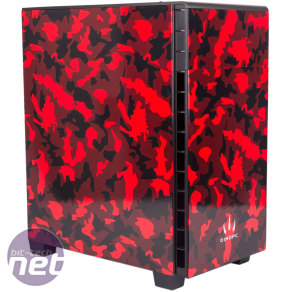
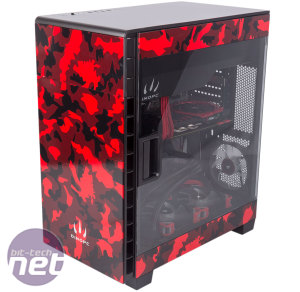
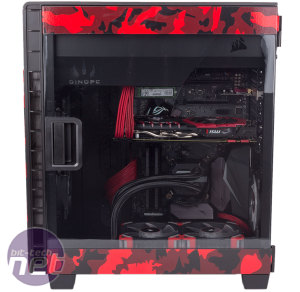
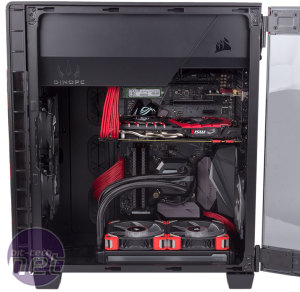
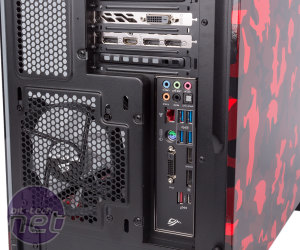
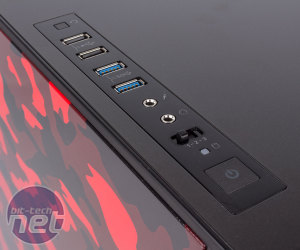

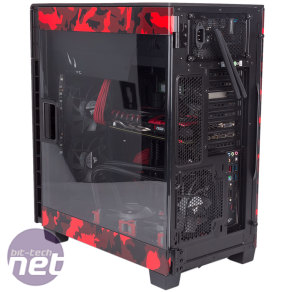
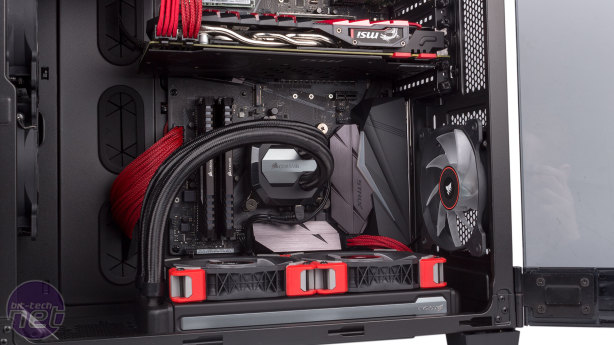
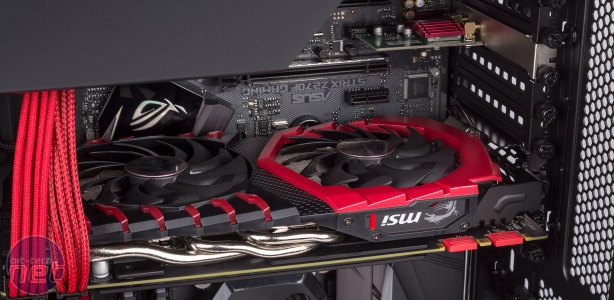
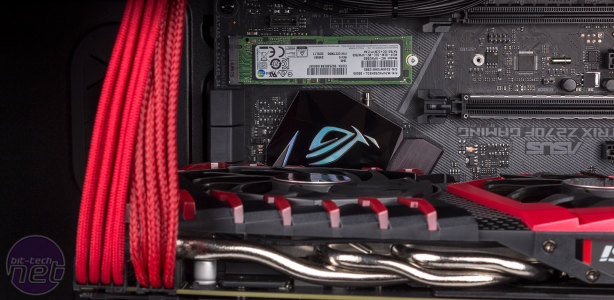
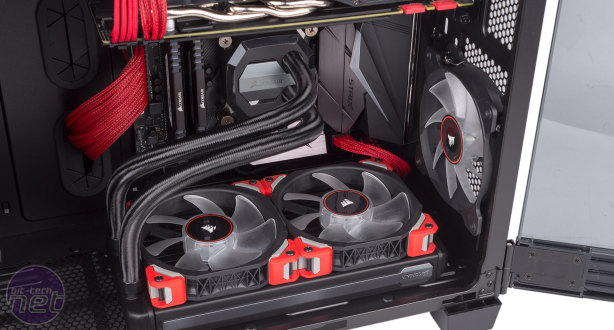
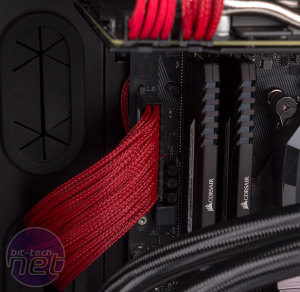
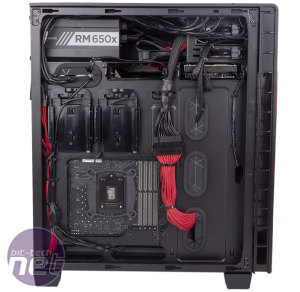
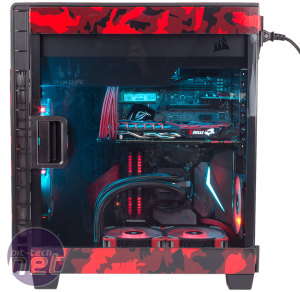

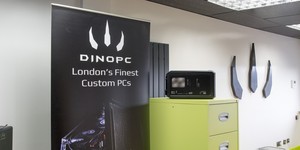
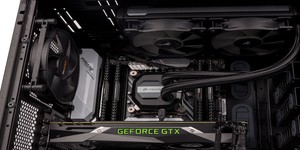





Want to comment? Please log in.